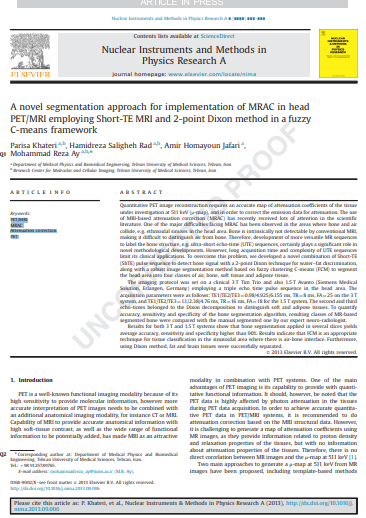A Novel Segmentation Approach for Implementation of MRAC in Head PET/MRI Employing Short-TE MRI and 2-Point Dixon Method in a Fuzzy C-Means Framework
Abstract
Quantitative PET image reconstruction requires an accurate map of attenuation coefficients of the tissue under investigation at 511 keV (μ-map), and in order to correct the emission data for attenuation. The use of MRI-based attenuation correction (MRAC) has recently received lots of attention in the scientific literature. One of the major difficulties facing MRAC has been observed in the areas where bone and air collide, e.g. ethmoidal sinuses in the head area. Bone is intrinsically not detectable by conventional MRI, making it difficult to distinguish air from bone. Therefore, development of more versatile MR sequences to label the bone structure, e.g. ultra-short echo-time (UTE) sequences, certainly plays a significant role in novel methodological developments. However, long acquisition time and complexity of UTE sequences limit its clinical applications. To overcome this problem, we developed a novel combination of Short-TE (ShTE) pulse sequence to detect bone signal with a 2-point Dixon technique for water–fat discrimination, along with a robust image segmentation method based on fuzzy clustering C-means (FCM) to segment the head area into four classes of air, bone, soft tissue and adipose tissue.
The imaging protocol was set on a clinical 3 T Tim Trio and also 1.5 T Avanto (Siemens Medical Solution, Erlangen, Germany) employing a triple echo time pulse sequence in the head area. The acquisition parameters were as follows: TE1/TE2/TE3¼0.98/4.925/6.155 ms, TR¼8 ms, FA¼25 on the 3 T system, and TE1/TE2/TE3¼1.1/2.38/4.76 ms, TR¼16 ms, FA¼18 for the 1.5 T system. The second and third echo-times belonged to the Dixon decomposition to distinguish soft and adipose tissues. To quantify accuracy, sensitivity and specificity of the bone segmentation algorithm, resulting classes of MR-based segmented bone were compared with the manual segmented one by our expert neuro-radiologist.
Results for both 3 T and 1.5 T systems show that bone segmentation applied in several slices yields average accuracy, sensitivity and specificity higher than 90%. Results indicate that FCM is an appropriate technique for tissue classification in the sinusoidal area where there is air-bone interface. Furthermore, using Dixon method, fat and brain tissues were successfully separated.

